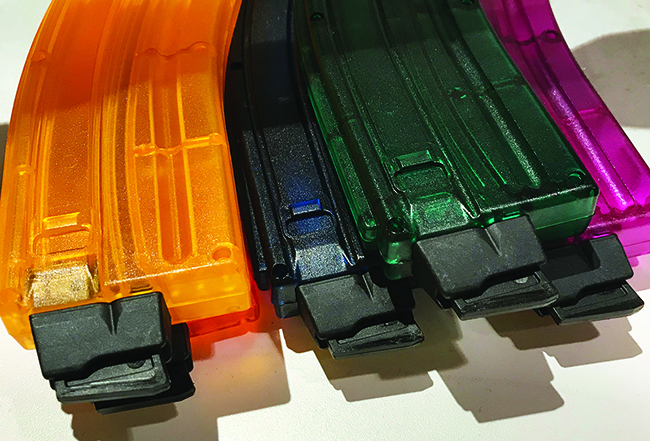How Psychology Of Color Impacts Buying Behavior
Pablo Picasso once said, “Colors, like features, follow the changes of the emotions.” What does this mean for retailers?
You may have put a lot of thought process into the colors of the paint on the walls of your retail store and of the outside of your building, but have you thought about the color of your products and the emotions they may convey to customers?
What Women Want
Yes, we can be annoyed with the “pink it and shrink it” approach, but it’s usually when someone makes an assumption simply based on us being female, and not respecting our individuality. As women, we can appreciate some people are just trying to be helpful, and then we can also gently educate them and lead them to more appropriate choices.
Yes, some women prefer black, but women also like colorful objects and sometimes “bling” as well. For myself, I pretty much live in black clothing, but with other items, I feel black is somewhat boring. Also, when many things are black it can lead to objects blending into each other and not standing out. For instance, as I’ve gotten older, black on black, such as a black Uplula inside a black bag, is hard to see and differentiate. Colors stand out and are easier to spot against a black background.
Going deeper, what if our enjoyment of color goes beyond liking “bling” or “pretty?” What if there’s a psychological reason for liking certain colors? Would it make you rethink the colors of the products you carry?
Color Psychology
Do a quick search online utilizing terms such as color psychology and you’ll come up with a mind-boggling number of articles explaining the thought process behind preferences for certain colors.
Russian artist Wassily Kandinsky is usually given the credit for coming up with “Color Theory,” which sought to understand the relationship between various colors and the emotions they elicit. (If you want to get even deeper into his theories, he also said colors have shapes.) He attended a concert and realized that music elicited emotions and determined colors do the same thing.
Back to how color relates to retail and advertising. Color Psychology: How Color Influences Decisions by Nick Babich has a powerful explanation of the importance of color choices in retail marketing.
“Colors send a message without being overt and can thus determine buying choices,” he said. “It only takes 90 seconds for a person to form an opinion about your product and it’s estimated up to 90% of that opinion is based on colors alone. Since color is often the first thing users notice, it has a huge impact on their thoughts. Color is a part of the language that designers use to communicate with their users. Having an understanding of color psychology is a key aspect of creating color palettes that increase conversion.”
How are colors described and what feelings are they thought to evoke? There are the “warm colors” of reds, oranges and yellows. Some consider these colors to be warm and comfortable. However, others think these colors are angry or powerful.
Then there are the “cool colors” of blues, purples and greens. Some feel these are calming colors or elicit feelings of trust, strength or health. Others find them boring.
Studies show some people correlate the color black with sadness, while others relate it to power or authority.
Babich discusses the importance of also being aware of the cultural meanings of various colors. He says brown can mean comfort in U.S. culture, but it stands for mourning in the Indian culture. In considering this, you’ll want to keep the culture of your target audience in mind.
Why Does It Matter?
How can you use this knowledge of color psychology to increase sales to women?
Babich explains men and women have different perceptions of color and he provides a chart showing color preferences.
Both genders like blue the best, although a larger percentage of men prefer it than women.
Women’s second preference is the color purple, yet purple doesn’t even register on the chart as favorable to men.
Interestingly, green is liked equally by men and women, while red is preferred slightly more by women than men.
Which colors are least liked by women (so would likely not be a sales strategy to appeal to us)? We tend to dislike orange the most, then brown, then gray. I was glad to find out I wasn’t alone in this. In high school, I worked for the school nurse and she gave me a color test one day. I had to line up little blocks of color from favorite to least favorite. Orange was my least favorite color. The nurse told me there was something wrong with me for choosing orange last. Apparently, though, I’m just an average woman.
The color choices may not only be about what we feel but about what we want others to feel, showing the image you want to project or the message you want to send. For instance, for some women, wearing a red suit is often considered a “power suit.” We’re projecting an image of strength and sending the message that we expect to be respected and taken seriously.
Of course, recognize not everyone will agree with every choice. Different people have different “interpretations” of color or different “feelings” about various colors, sometimes based on their life experiences. Maybe Grandma’s favorite color was pink so we associate it with fond memories of her.
Do Colors Sell?
mpany that offers a wide variety of color choices to its customers. According to a customer service representative, while black is their best-selling color, the next bestsellers are purple, pink and Robin egg blue. The variety of colors they offer was enough to grab my attention at SHOT Show a few years back, prompting me to take a picture of their display.
Remember earlier when we learned red is liked by both men and women, with women liking it slightly more? This resonated with me. While I don’t have a particular favorite color, I’m often drawn to red. My only impulse firearm buy was when I walked into a gun shop and saw the eye-catching, stunning red on a Ruger 22/45 Lite. (“I need that,” I said immediately.)
While I had been considering a new .22, literally all it took for me to make the decision then and there and stop looking was a color. I walked out of the store with the gun that day. I also have red holsters and mag holsters.
Let Women Show You Which Colors They Prefer
The bottom line: there’s a lot of research discussing how colors can affect a person and their purchasing decisions. You don’t have to decide which specific colors get women to buy; simply provide a variety of colors to select from and let your sales show which colors are most popular. From there you can determine what sells best and begin stocking more products in those colors. Try it out!





